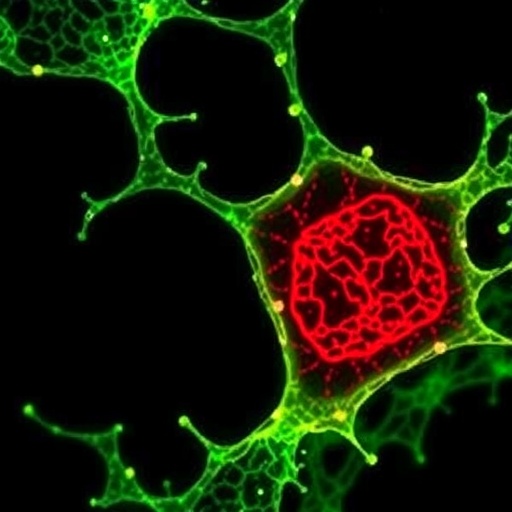Recent advancements in tissue engineering have paved the way for significant breakthroughs in the regenerative medicine sector. Among these, a pivotal study elucidates the transformative potential of extracellular matrix (ECM) nanostructures extracted from decellularized small intestines. The paper, authored by Fukada, S.L. U, and Nakamura in the Journal of Artificial Organs, embarks on a journey to understand how these nanostructures can influence the differentiation of intestinal epithelial model cells.
The extracellular matrix, a complex network of proteins and carbohydrates, plays a crucial role in cellular behavior and tissue homeostasis. While it is widely recognized that the ECM provides structural support and biochemical cues for cells, the intricacies of its nanostructural properties and their subsequent biological implications have remained underexplored. This study attempts to bridge that knowledge gap by meticulously analyzing how the nanostructures within the ECM of a decellularized small intestine can significantly alter cell differentiation processes.
In the study, the researchers utilized a decellularized small intestinal scaffold, a promising candidate due to its inherent biocompatibility and resemblance to native tissues. By eliminating the cellular components while retaining the ECM architecture, the researchers created a model that closely mimics the natural environment of intestinal epithelial cells. This decellularization process ensures that the inherent molecular signals embedded within the ECM remain intact, allowing for the examination of their specific effects on cellular behavior.
A key finding of this investigation is the ability of the ECM nanostructures to enhance the differentiation of intestinal epithelial model cells. Through a series of meticulous in vitro experiments, it was demonstrated that the physical and biochemical properties of these nanostructures critically influence not only the cellular morphology but also the functionality of the epithelial cells. This indicates that the ECM’s characteristics contribute not just to providing support but also to orchestrating vital cell signaling pathways that govern differentiation.
The influence of spatial architecture on cellular fate is a focal point in tissue engineering. According to the study, the unique nanostructural features of the decellularized small intestine scaffold offer a rich tapestry that guides stem or progenitor cells towards a specific differentiation pathway. This nuanced interaction highlights the importance of mimicking the native tissue microenvironment in regenerative medicine applications, paving the way for optimized therapeutic strategies.
Moreover, this research touches upon the potential implications for developing advanced tissue-engineered constructs, where controlling the ECM properties can lead to enhanced functionality of the resulting tissues. The ability to direct cell fate through ECM cues not only opens new avenues for understanding tissue regeneration but also pushes the envelope in designing functional intestinal models for drug testing and disease modeling.
Furthermore, the study emphasizes the translation of these findings into clinical applications. The optimization of ECM properties for creating functional intestinal tissues could potentially provide innovative solutions for patients suffering from gastrointestinal diseases, where tissue loss and dysfunction are prevalent. By harnessing the regenerative capabilities of ECM nanostructures, there lies an opportunity for developing transplantation strategies to restore intestinal function.
As the research progresses, the authors speculate about the broader implications of applying their insights to other organ systems. If the ECM from different tissues can yield similar outcomes, this could revolutionize how tissue engineering strategies are approached, highlighting the importance of tissue-specific ECM features in guiding cellular responses. This could lead to a paradigm shift in regenerative medicine, where tailored constructs based on ECM characteristics could provide optimal therapeutic responses.
The high relevance of this study is underscored by the growing interest in the field of 3D bioprinting and biofabrication technologies. As researchers seek to design complex tissue models that can replicate the architecture and function of native organs, understanding the role of ECM nanostructures becomes imperative. This exploration serves as a foundational stone upon which future innovations will be built, setting the stage for incredible advancements in science and medicine.
In conclusion, Fukada, U, and Nakamura’s groundbreaking research not only enriches our comprehension of ECM biology but also serves as a catalyst for future investigations into regenerative medicine. By unveiling how ECM nanostructures can orchestrate cellular differentiation, this study charts a compelling path toward the development of sophisticated, functional tissues that can tackle the pressing challenges of organ failure and disease. As the scientific community integrates these findings, the potential for creating therapies that can save lives and enhance health continues to widen, offering a glimpse of what the future holds for tissue engineering applications.
The interplay between ECM characteristics and cellular function reflects fundamental principles in biology that can no longer be overlooked. With ongoing studies and innovative approaches, there is no doubt that this area of research will continue to flourish, bringing us closer to realizing the dreams of regenerative medicine. The time has come for researchers and practitioners alike to consider the profound implications of these discoveries and embrace the future of medicine shaped by the intricate dance of cells and their extracellular matrix.
Subject of Research: The role of ECM nanostructures in influencing the differentiation of intestinal epithelial model cells from decellularized small intestine.
Article Title: Effect of ECM nanostructures in decellularized small intestine on differentiation of intestinal epithelial model cells.
Article References:
Fukada, T., U, S.L. & Nakamura, N. Effect of ECM nanostructures in decellularized small intestine on differentiation of intestinal epithelial model cells.
J Artif Organs (2025). https://doi.org/10.1007/s10047-025-01509-8
Image Credits: AI Generated
DOI: 10.1007/s10047-025-01509-8
Keywords: ECM nanostructures, decellularized small intestine, intestinal epithelial cells, tissue engineering, regenerative medicine.




